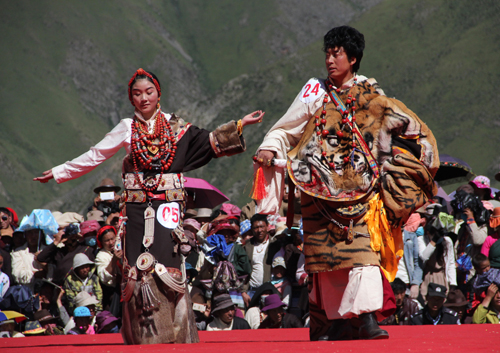
(TibetanReview.net, Aug16, 2015) – Apart from Nangchen (Chinese Nangqian) County in Yulshul (Yushu) Prefecture of Qinghai Province, Chinese authorities in Driru (Biru) County of Nagchu (Naqu) Prefecture of Tibet Autonomous Region had also ordered Tibetans to wear fur designed traditional costumes on China’s army day of Aug 1 or face severe punishment, said Dharamshala-based Tibetan Centre for Human Rights and Democracy Aug 10.
It said that in Nangchen County’s Kashung Township, county officials accompanied by China’s paramilitary police attacked sleeping Tibetans in their homes with hammers, sticks, knives and stones while Teargas shells were also fired in the night of Aug 5. The exile Tibetan administration at Dharamshala said on its Tibet.net website Aug 11 that the Chinese were unhappy and angry that Tibetans did not display happiness due to the fur costume order during the cultural shows on Aug 1 and that this mood had continued on the following days’ celebrations.
It remains unclear how many were injured or severely so. The centre named three of the injured taken to the Yulshul prefecture hospital as Tadul, Shopel, and Budar – all belonging to the Sengmey nomadic camp. It also named one of the most severely injured taken to the provincial hospital in Xining as Adhor, adding he was unlikely to survive.
The centre also said that in Driru (Chinese: Biru) County of Nagchu Prefecture, Tibet Autonomous Region, too, the Chinese authorities ordered Tibetans to wear traditional Tibetan costumes trimmed with furs of endangered wild lives during the celebrations while performers were especially provided such clothing by the authorities.
The centre said that ahead of the army day, the local Chinese authorities issued a ‘four absolute dos’ order, mandating: “Art and cultural shows must be organized; Songs and dances must be performed on stages; Performers must wear clothes trimmed with animal fur; the public, in and around Diru, must come to watch the art and cultural shows.”
Those failing to comply with the order concerning the wearing of furred costumes, it was warned, would be banned from the Yartsa Gunbu (caterpillar fungus) hunting season for five years. The medicinal herb growing out in summer in high altitude mountains from the body of winter caterpillars is the main source of income for the local Tibetans.
Furs of wild lives were part of traditional costumes on festive occasions in many parts of Tibet. However, given the growing global revulsion against the use of animal furs, especially of endangered wild lives, and Tibet’s exiled spiritual leader, the Dalai Lama’s advice against such kind of traditional clothing, most of the Tibetans have given it up altogether. And they felt that the Chinese were deliberately trying to present them in bad light by forcing them to wear such clothing.


